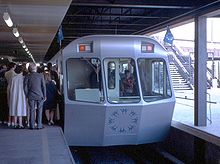Expo Express
The Expo Express (French: l'express Expo ) was an overground high-speed train that was built for the Expo 67 world exhibition in Montreal .
The 5.7 kilometer stretch was part of the Montreal subway and cost around 18 million Canadian dollars . A train could transport up to 1,000 visitors per hour and headed for five stations in each direction. After the World's Fair , the railroad became the property of the city of Montreal and the trains ran on a shortened route until their operations were completely stopped in 1972.
history
In contrast to the monorail Minirail by Willy Habegger , which operated only inside the World Expo site, the Expo Express conventional used underground technique with two rails and for driving a power rail , thus following the same principle as the Toronto subway . The railway operated from April 1967 to October 1972. After the cessation of operations, a few trains were still deposited in a locomotive shed at the La Ronde amusement park until the summer of 1979 . When the construction of a temporary line to the Cité du Havre peninsula began, they were moved to the Montreal port .
Today the yellow line 4 still exists , which leads from the Île de Montréal to the east bank of the Saint Lawrence River to Longueuil . There have been several attempts to continue using the original Expo Express trains: after they were brought from the port to a warehouse in Les Cèdres in the late 1980s and no use for them was found there, they were finally scrapped in the mid-1990s .
Rolling stock and technology
The trains were a modified version of the so-called H series of the British aircraft manufacturer Hawker Siddeley Canada Limited in Thunder Bay , which expanded its business field in 1957 to the production of locomotives and electrical equipment. The Toronto subway also uses the same rolling stock, but with the difference that the sides of the Expo Express were each equipped with one fewer door and the ends were streamlined.
The Expo Express was the first fully automated mass transit system in North America . The ATO system (from Automatic Train Operation ) used for this was based on the principle of the audio frequency track circuit , which had been set up by the American train safety company Union Switch & Signal . The fact that the train could run fully automatically was not generally known during the world exhibition. It was not widely advertised because it was feared that the visitors would otherwise not dare to be transported by a computer-controlled train. In order not to worry the passengers, an employee was put at the head of each train, who only operated the train's doors.
The train fleet consisted of a total of 48 cars, each composed of six trains with six cars. Each car had 80 seats and around 90 standing places. The Expo Express drove on conventional steel wheels, in contrast to the Montreal subway, which used rubber-tired trains.
Routing
The line began at Place d'Accueil on the Cité du Havre peninsula and had the following stations, some of which could only be used in one direction:
- Cité du Havre / Place d'Accueil, closed in 1968
- Habitat 67 (only towards the city), closed in 1968
- Île Sainte-Hélène
- Île Notre-Dame
- L'homme et l'agriculture (only towards Expo), added in 1968
- La Ronde
The line was basically double-tracked except for a short single-track section at Place d'Accueil, where visitors got off on one side of the train and got on on the other. When the train was brought to the final stop on Île Sainte-Hélène, the Expo Express was also only operated on a single track. To the north of the Île Notre-Dame, the line for the construction of the Olympic pool was dismantled. The facilities for maintaining the railway were located at the La Ronde stop.
literature
- Official Expo 1967 Guide Book . MacLean-Hunter Publishing Co. Ltd. Toronto 1967, p. 16.
- Monika Meyer-Künzel: Urban development of the world exhibitions and the Olympic Games: urban development of the venues , Dölling and Galitz 2001, ISBN 978-3933374899 , p. 259, digitized .
- American Institute of Planners (Ed.): Journal of the American Institute of Planners , The Institute 1967, Issue 33, ISSN 0002-8991 , p. 269.
Web links
- Information and pictures of the Expo Express (English)
- Expo 17 Proposal, page 41 (English, PDF, 4.6 MB)
Individual evidence
- ↑ Meyer-Künzel, p. 259.
- ↑ American Society of Civil Engineers (Ed.): Civil engineering ASCE , Issue 37, 1967, ISSN 0360-0556 , p. 42.


